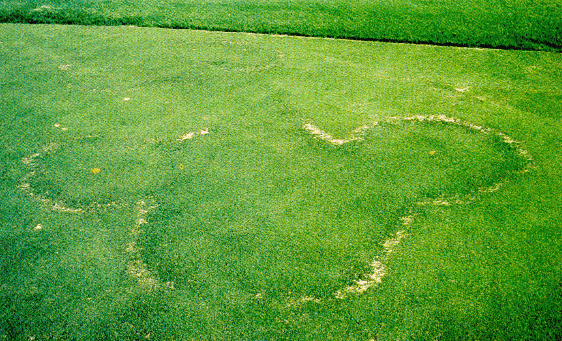Sometimes bad things happen even to the healthiest lawns. Lawn diseases are bad things. They can be difficult to distinguish from other problems such as pests and poor maintenance. We have some tips to help you identify your lawn problems. Chances are that some of you reading this already have a disease problem. If so, the most common control is to use a fungicide. Various types of fungicide exist, so if you’re tempted to do it yourself, make sure you use the right one.
 Brown Patch – commonly starts as a small spot and can quickly spread outward in a circular or horseshoe pattern sometimes as large as two feet wide. Often times, while expanding outward, the inside of the circle will recover, leaving brown areas resembling a smoke ring. The best prevention for brown patch is to aerate often, reduce shade to affected areas and follow a low nitrogen fertilization schedule.
Brown Patch – commonly starts as a small spot and can quickly spread outward in a circular or horseshoe pattern sometimes as large as two feet wide. Often times, while expanding outward, the inside of the circle will recover, leaving brown areas resembling a smoke ring. The best prevention for brown patch is to aerate often, reduce shade to affected areas and follow a low nitrogen fertilization schedule. Dollar Spot – gets its name from small silver dollar size brown spots. Dollar spots tend to thrive during drought conditions with heavy dews in lawns with low levels of nitrogen. The best prevention for dollar spot is aerate often, water well in the mornings, remove excess thatch and follow a fertilization schedule to help increase the amount of nitrogen levels in your lawn.
Dollar Spot – gets its name from small silver dollar size brown spots. Dollar spots tend to thrive during drought conditions with heavy dews in lawns with low levels of nitrogen. The best prevention for dollar spot is aerate often, water well in the mornings, remove excess thatch and follow a fertilization schedule to help increase the amount of nitrogen levels in your lawn. Rust – gets its name from the orange “rusty” appearance it gives leaf blades. Rust tends to flourish in conditions of morning dew, shade, high soil compaction and low fertility. The best prevention for rust is to aerate your lawn, water well in the morning hours, reduce shade to grass, mow more frequently and bag grass clippings. Follow a fertilization schedule to help increase the amount of nitrogen levels in your lawn.
Rust – gets its name from the orange “rusty” appearance it gives leaf blades. Rust tends to flourish in conditions of morning dew, shade, high soil compaction and low fertility. The best prevention for rust is to aerate your lawn, water well in the morning hours, reduce shade to grass, mow more frequently and bag grass clippings. Follow a fertilization schedule to help increase the amount of nitrogen levels in your lawn. Fairy Rings – Fairy rings can grow in most grasses, and are distinguishable by circular rings filled with fast growing dark green grass. Around the perimeter of the ring, the grass will typically turn brown and after time grow mushrooms. Fairy rings typically grow in soils that contain wood debris and decaying tree stumps. The best prevention for fairy rings is to aerate the diseased area, water well in the morning, remove excess thatch, and fertilize more to increase the amount of nitrogen levels in your lawn.
Fairy Rings – Fairy rings can grow in most grasses, and are distinguishable by circular rings filled with fast growing dark green grass. Around the perimeter of the ring, the grass will typically turn brown and after time grow mushrooms. Fairy rings typically grow in soils that contain wood debris and decaying tree stumps. The best prevention for fairy rings is to aerate the diseased area, water well in the morning, remove excess thatch, and fertilize more to increase the amount of nitrogen levels in your lawn. Powdery Mildew – Grass looks as though it is sprinkled with flour. Shady areas are the most susceptible. Grass will wither and die. Water only in the morning, reduce shade by pruning trees, aerate and check drainage in the area.
Powdery Mildew – Grass looks as though it is sprinkled with flour. Shady areas are the most susceptible. Grass will wither and die. Water only in the morning, reduce shade by pruning trees, aerate and check drainage in the area.